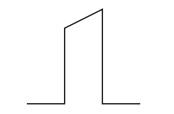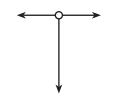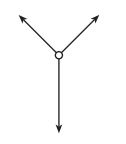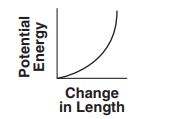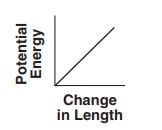1. Which quantities are scalar?
(1) speed and work
(2) velocity and force
(3) distance and acceleration
(4) momentum and power
2. A -kilogram mass is thrown vertically upward with an initial speed of
meters per second. What is the maximum height this object will reach? [Neglect friction.]
(1) m
(2) m
(3) m
(4) m
3. An airplane traveling north at meters per second encounters a
-meters-per-second crosswind from west to east, as represented in the diagram below.
What is the resultant speed of the plane?
(1) m/s
(2) m/s
(3) m/s
(4) m/s
4. A -kilogram space vehicle is traveling along a straight line at a constant speed of
meters per second. The magnitude of the net force on the space vehicle is
(1) N
(2) N
(3) N
(4) N
5. A student throws a -newton ball straight up. What is the net force on the ball at its maximum height?
(1) N
(2) N, up
(3) N, down
(4) N, down
6. A vertical spring has a spring constant of newtons per meter. When an object is attached to the bottom of the spring, the spring changes from its unstretched length of
meter to a length of
meter. The magnitude of the weight of the attached object is
(1) N
(2) N
(3) N
(4) N
7. A -kilogram cart initially moves at
meters per second. It is brought to rest by a constant net force in
second. What is the magnitude of the net force?
(1) N
(2) N
(3) N
(4) N
8. Which characteristic of a light wave must increase as the light wave passes from glass into air?
(1) amplitude
(2) frequency
(3) period
(4) wavelength
9. As a -newton basketball player jumps from the floor up toward the basket, the magnitude of the force of her feet on the floor is
newtons. As she jumps, the magnitude of the force of the floor on her feet is
(1) N
(2) N
(3) N
(4) N
10. A -kilogram ball traveling at
meters per second hits a concrete wall. What speed must a
-kilogram bullet have in order to hit the wall with the same magnitude of momentum as the ball?
(1) m/s
(2) m/s
(3) m/s
(4) m/s
11. The Hubble telescope’s orbit is meters above Earth’s surface. The telescope has a mass of
kilograms. Earth exerts a gravitational force of
newtons on the telescope. The magnitude of Earth’s gravitational field strength at this location is
(1) N/kg
(2) N/kg
(3) N/kg
(4) N/kg
12. When two point charges are a distance apart, the magnitude of the electrostatic force between them is
. If the distance between the point charges is increased to
, the magnitude of the electrostatic force between the two charges will be
(1)
(2)
(3)
(4)
13. A radio operating at volts and a constant temperature draws a current of
ampere. What is the resistance of the radio circuit?
(1)
(2)
(3)
(4)
14. Which energy transformation occurs in an operating electric motor?
(1) electrical mechanical
(2) mechanical electrical
(3) chemical electrical
(4) electrical chemical
15. A block slides across a rough, horizontal tabletop. As the block comes to rest, there is an increase in the block-tabletop system’s
(1) gravitational potential energy
(2) elastic potential energy
(3) kinetic energy
(4) internal (thermal) energy
16. How much work is required to move an electron through a potential difference of volts?
(1) J
(2) J
(3) J
(4) J
17. During a laboratory experiment, a student finds that a Celsius, a
-meter length of copper wire has a resistance of
ohms. The cross-sectional area of this wire is
(1)
(2)
(3)
(4)
18. A net charge of coulombs passes a point on a conductor in
second. The average current is
(1) A
(2) A
(3) A
(4) A
19. If several resistors are connected in series in an electric circuit, the potential difference across each resistor
(1) varies directly with its resistance
(2) varies inversely with its resistance
(3) varies inversely with the square of its resistance
(4) is independent of its resistance
20. The amplitude of a sound wave is most closely related to the sound’s
(1) speed
(2) wavelength
(3) loudness
(4) pitch
21. A duck floating on a lake oscillates up and down times during a
-second interval as a periodic wave passes by. What is the frequency of the duck’s oscillations?
(1) Hz
(2) Hz
(3) Hz
(4) Hz
22. Which diagram best represents the position of a ball, at equal time intervals, as it falls freely from rest near Earth’s surface?
(1)
(2)
(3)
(4)
23. A gamma ray and a microwave traveling in a vacuum have the same
(1) frequency
(2) period
(3) speed
(4) wavelength
24. A student produces a wave in a long spring by vibrating its end. As the frequency of the vibration is doubled, the wavelength in the spring is
(1) quartered
(2) halved
(3) unchanged
(4) doubled
25. Which two points on the wave shown in the diagram below are in phase with each other?
(1) and
(2) and
(3) and
(4) and
26. As a longitudinal wave moves through a medium, the particles of the medium
(1) vibrate parallel to the direction of the wave’s propagation
(2) vibrate perpendicular to the direction of the wave’s propagation
(3) are transferred in the direction of the wave’s motion, only
(4) are stationary
27. Wind blowing across suspended power lines may cause the power lines to vibrate at their natural frequency. This often produces audible sound waves. This phenomenon, often called an Aeolian harp, is an example of
(1) diffraction
(2) the Doppler effect
(3) refraction
(4) resonance
28. A student listens to music from a speaker in an adjoining room, as represented in the diagram below.
She notices that she does not have to be directly in front of the doorway to hear the music. This spreading of sound waves beyond the doorway is an example of
(1) the Doppler effect
(2) resonance
(3) refraction
(4) diffraction
29. What is the minimum energy required to ionize a hydrogen atom in the state?
(1) eV
(2) eV
(3) eV
(4) eV
Base your answers to questions 30 and 31 on the diagram below and on your knowledge of physics.
The diagram represents two small, charged, identical metal spheres, and
that are separated by a distance of
meters.
30. What is the magnitude of the electrostatic force exerted by sphere on sphere
?
(1) N
(2) N
(3) N
(4) N
31. If the two spheres were touched together and then separated, the charge on sphere would be
(1) C
(2) C
(3) C
(4) C
32. The horn of a moving vehicle produces a sound of constant frequency. Two stationary observers, and
, and the vehicle’s driver
, positioned as represented in the diagram below, hear the sound of the horn.
Compared to the frequency of the sound of the horn heard by driver , the frequency heard by observer
is
(1) lower and the frequency heard by observer is lower
(2) lower and the frequency heard by observer is higher
(3) higher and the frequency heard by observer is lower
(4) higher and the frequency heard by observer is higher
33. A different force is applied to each of four different blocks on a frictionless, horizontal surface. In which diagram does the block have the greatest inertia seconds after starting from rest?
(1)
(2)
(3)
(4)
34. The diagram below shows a ray of monochromatic light incident on a boundary between air and glass.
Which ray best represents the path of the reflected light ray?
(1)
(2)
(3)
(4)
35. Two pulses approach each other in the same medium. The diagram below represents the displacements caused by each pulse.
Which diagram best represents the resultant displacement of the medium as the pulses pass through each other?
(1)
(2)
(3)
(4)
36. The diameter of an automobile tire is closest to
(1) m
(2) m
(3) m
(4) m
37. The vector diagram below represents the velocity of a car traveling meters per second
east of north.
What is the magnitude of the component of the car’s velocity that is directed eastward?
(1) m/s
(2) m/s
(3) m/s
(4) m/s
38. Without air resistance, a kicked ball would reach a maximum height of meters and land
meters away. With air resistance, the ball would travel
(1) m vertically and more than
m horizontally
(2) m horizontally and less than
m vertically
(3) more than m vertically and less than
m horizontally
(4) less than m horizontally and less than
m vertically
39. A car is moving with a constant speed of meters per second. What total distance does the car travel in
minutes?
(1) m
(2) m
(3) m
(4) m
40. A car, initially traveling at meters per second north, accelerates to
meters per second north in
seconds. The magnitude of the average acceleration is
(1)
(2)
(3)
(4)
41. An object is in equilibrium. Which force vector diagram could represent the force(s) acting on the object?
(1)
(2)
(3)
(4)
42. Which combination of fundamental units can be used to express the amount of work done on an object?
(1)
(2)
(3)
(4)
43. Which graph best represents the relationship between the potential energy stored in a spring and the change in the spring’s length from its equilibrium position?
(1)
(2)
(3)
(4)
44. An electric motor has a rating of watts. How much time will it take for this motor to lift a
-kilogram mass a vertical distance of
meters? [Assume 100% efficiency.]
(1) s
(2) s
(3) s
(4) s
45. A compressed spring in a toy is used to launch a -gram ball. If the ball leaves the toy with an initial horizontal speed of
meters per second, the minimum amount of potential energy stored in the compressed spring was
(1) J
(2) J
(3) J
(4) J
46. A ray of yellow light (Hz) travels at a speed of
meters per second in
(1) ethyl alcohol
(2) water
(3) Lucite
(4) glycerol
47. A blue-light photon has a wavelength of meter. What is the energy of the photon?
(1) J
(2) J
(3) J
(4) J
48. The graph below represents the relationship between the force exerted on an elevator and the distance the elevator is lifted.
How much total work is done by the force in lifting the elevator from m to
m?
(1) J
(2) J
(3) J
(4) J
49. The diagram below shows waves and
in the same medium.
Compared to wave , wave
has
(1) twice the amplitude and twice the wavelength
(2) twice the amplitude and half the wavelength
(3) the same amplitude and half the wavelength
(4) half the amplitude and the same wavelength
50. What is the quark composition of a proton?
(1) uud
(2) udd
(3) csb
(4) uds













